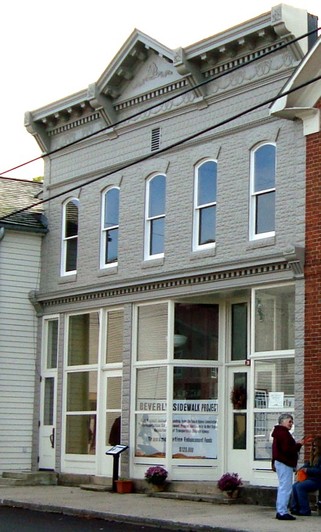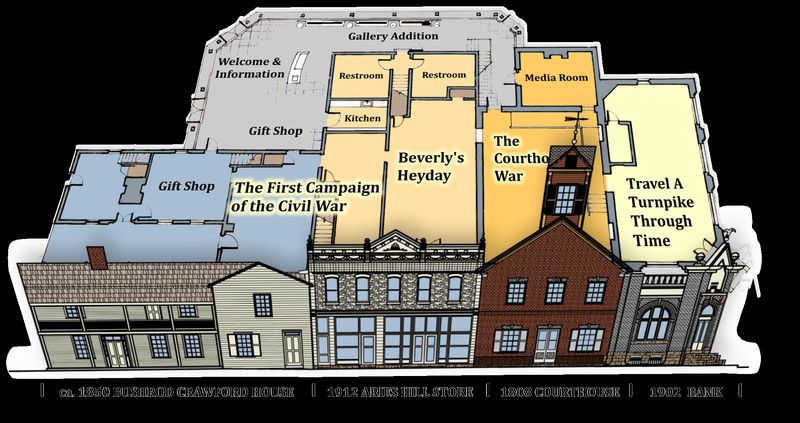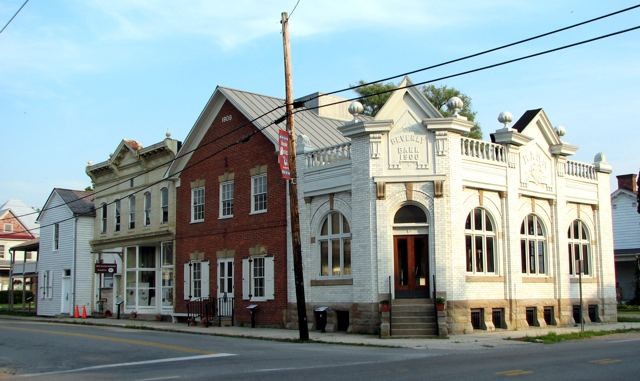Hill Building
Introduction
Text-to-speech Audio
Images
The Hill building, constructed in 1907. Courtesy of Historic Beverly Preservation, Inc.

Interior map of the Beverly Heritage Center, which combined the Hill building with three other structures on Court Street. Courtesy of the Beverly Heritage Center.

Exterior view of the Beverly Heritage Center, opened in 2012. Courtesy of Historic Beverly Preservation, Inc.

Backstory and Context
Text-to-speech Audio
When Aries Hill had his general store constructed on Court Street in 1907, he sought to participate in ongoing efforts to promote trade and business in the town after the “Randolph County Courthouse War” of the 1890s, a struggle between the rapidly growing town of Elkins and Beverly itself for control of area politics. His store, built in the Neoclassical Revival style, evidently did well, and when Hill died from pneumonia in 1923 he was one of the most prosperous and influential men in Beverly. Hill’s experiences are representative not only of the efforts of former Confederates to reintegrate into West Virginia society after the Civil War, but also those of Beverly more generally as it worked to find a new place for itself in the changing political landscape of an Elkins-led county government.
Aries Hill arrived in Beverly, West Virginia shortly after it lost its status as the seat of Randolph County to nearby Elkins, which rose to that position in 1899 after years of political strife, occasional violence, and the presumed 1897 arson of a new courthouse building constructed in Beverly three years earlier. Eager in the wake of that conflict’s resolution to head off their town’s anticipated regional diminution, Beverly’s residents sought to encourage an economic revival in their town with the construction of a series of prominent new buildings that effectively reworked the architectural landscape of the area. Among these structures were the Masonic Lodge, the International Organization of Odd Fellows (I.O.O.F.) Hall, the Beverly Store, and the Hill building itself. While these structures embraced a variety of architectural features, the Hill building is in the Neoclassical Revival style. The pediment (triangular shape at the top of the building’s facade) and metal cornices (ornamental molding) are particularly representative of this style, as are the pressed metal “stones” on the left and right edges of the building simulating pilasters (rectangular columns). Together with the structure’s double storefront, these features made the Hill building an eye-catching sight on Court Street during its heyday in the early twentieth century. As a result Hill’s business prospered, and he eventually became one of the town’s most notable citizens.
Aries Hill was not always as fortunate as he had become by the end of his life. After his service in the Confederate Army during the American Civil War, Hill struggled to establish a successful business in Randolph County. He tried and failed on a number of occasions to obtain a liquor license in the area, where the temperance (anti-alcohol) movement had evidently gained considerable traction in the post-war years. In a particularly low point, Hill shot himself in the finger while inspecting a revolver. After moving to Beverly in 1902 to serve as the clerk of local tavern-keeper John Feight, however, his luck began to turn, and within five years he had opened the new general store next to the Old Beverly Courthouse that would eventually come to bear his name. In a particularly symbolic design choice, Hill’s new store not only replaced the clerk’s office that once occupied a wing of the courthouse but obscured a portion of the courthouse itself as well. The new county courthouse in Elkins had replaced the one in Beverly and the town’s residents, it seemed, were ready to move on.
While a slight majority of the Randolph County electorate supported the Confederacy in the Civil War, the post-war years in that area progressed in much the same manner as they did in others throughout the new state of West Virginia. Hill’s struggles to find a place for himself as a Confederate veteran in a Union state were fairly typical of those experienced by many of his compatriots, especially during the years of Reconstruction. A majority of West Virginians were at the very least Unionists, often members of the Republican Party, and increasingly supportive of the efforts of Progressive reformers who supported temperance. Hill’s eventual decision to move away from the liquor business reflected an acknowledgment that such enterprises were becoming less and less popular not only in Randolph County but across the state. The success he experienced after that decision, early in the twentieth century, was in large part a result not only of his choice to become the proprietor of a “respectable” business but of a larger shift in West Virginia’s political landscape as well that tended toward support for the reintegration of former Confederates into society.
The Hill building thus serves as a window into the history of both Beverly in the wake of the “Courthouse War” of the 1890s and West Virginia at large in the wake of the Civil War. As part of the Beverly Heritage Center, however, it also serves as a central component in the area’s historical community. Formed in the early twentieth century through a cooperation between Historic Beverly Preservation, the Rich Mountain Battlefield Foundation, and the Staunton-Parkersburg Turnpike Alliance, the Beverly Heritage Center is key to local efforts at historical education and preservation.
Sources
"Aries Hill Is Dead, Victim of Pneumonia." The Bluefield Daily Telegraph, March 18, 1923.
"Beverly: A More Complete History (part Three of Three)." HistoricBeverly.org. Accessed July 21, 2019. http://www.historicbeverly.org/wordpress/beverly-a-more-complete-history-part-three-of-three/.
"Beverly's Historic Architecture." HistoricBeverly.org. Accessed July 21, 2019. http://www.historicbeverly.org/archper.htm.
Bosworth, A. S. A History of Randolph County West Virginia: From Its Earliest Exploration and Settlement to the Present Time. Elkins, WV, 1898.
Hickman, Deborah L. Faded Ages, A History: Traditional Life Styles of Appalachia. Accessed July 21, 2019. http://pages.swcp.com/~dhickman/pubs/fadeages.html.
